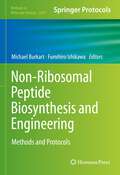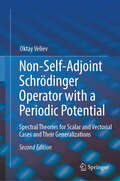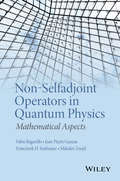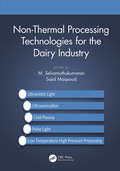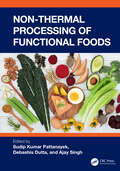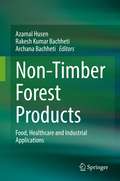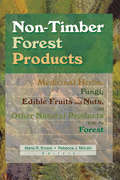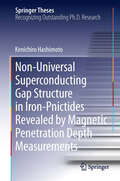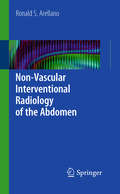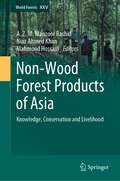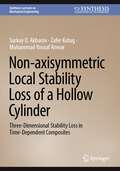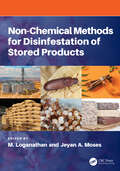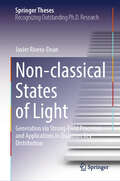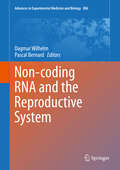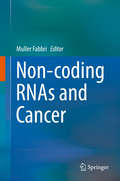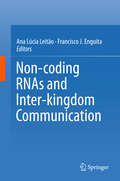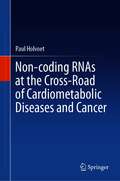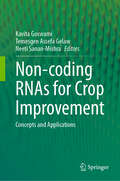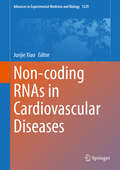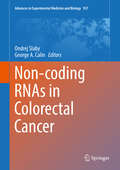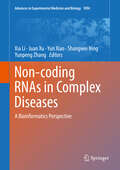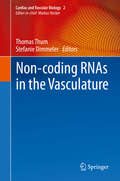- Table View
- List View
Non-Ribosomal Peptide Biosynthesis and Engineering: Methods and Protocols (Methods in Molecular Biology #2670)
by Michael Burkart Fumihiro IshikawaThis volume provides new technologies on NRPSs and related carrier protein dependent synthases, including polyketide synthases (PKS) and fatty acid synthases (FAS). Chapters detail enzymology, structural biology, proteopromics, chemical biology, natural product chemistry, and bioinformatics. Written in the format of the highly successful Methods in Molecular Biology series, each chapter includes an introduction to the topic, lists necessary materials and methods, includes tips on troubleshooting and known pitfalls, and step-by-step, readily reproducible protocols. Authoritative and cutting-edge, Non-Ribosomal Peptide Biosynthesis and Engineering: Methods and Protocols aims to feature methods that will be beneficial to new researchers, and those wanting to adopt new methodologies into their research.
Non-Self-Adjoint Schrödinger Operator with a Periodic Potential: Spectral Theories for Scalar and Vectorial Cases and Their Generalizations
by Oktay VelievThis book offers a comprehensive exploration of spectral theory for non-self-adjoint differential operators with complex-valued periodic coefficients, addressing one of the most challenging problems in mathematical physics and quantum mechanics: constructing spectral expansions in the absence of a general spectral theorem. It examines scalar and vector Schrödinger operators, including those with PT-symmetric periodic optical potentials, and extends these methodologies to higher-order operators with periodic matrix coefficients. The second edition significantly expands upon the first by introducing two new chapters that provide a complete description of the spectral theory of non-self-adjoint differential operators with periodic coefficients. The first of these new chapters focuses on the vector case, offering a detailed analysis of the spectral theory of non-self-adjoint Schrödinger operators with periodic matrix potentials. It thoroughly examines eigenvalues, eigenfunctions, and spectral expansions for systems of one-dimensional Schrödinger operators. The second chapter develops a comprehensive spectral theory for all ordinary differential operators, including higher-order and vector cases, with periodic coefficients. It also includes a complete classification of the spectrum for PT-symmetric periodic differential operators, making this edition the most comprehensive treatment of these topics to date. The book begins with foundational topics, including spectral theory for Schrödinger operators with complex-valued periodic potentials, and systematically advances to specialized cases such as the Mathieu–Schrödinger operator and PT-symmetric periodic systems. By progressively increasing the complexity, it provides a unified and accessible framework for students and researchers. The approaches developed here open new horizons for spectral analysis, particularly in the context of optics, quantum mechanics, and mathematical physics.
Non-Selfadjoint Operators in Quantum Physics
by Franciszek Hugon Szafraniec Fabio Bagarello Jean-Pierre Gazeau Miloslav ZnojilA unique discussion of mathematical methods with applications to quantum mechanics Non-Selfadjoint Operators in Quantum Physics: Mathematical Aspects presents various mathematical constructions influenced by quantum mechanics and emphasizes the spectral theory of non-adjoint operators. Featuring coverage of functional analysis and algebraic methods in contemporary quantum physics, the book discusses the recent emergence of unboundedness of metric operators, which is a serious issue in the study of parity-time-symmetric quantum mechanics. The book also answers mathematical questions that are currently the subject of rigorous analysis with potentially significant physical consequences. In addition to prompting a discussion on the role of mathematical methods in the contemporary development of quantum physics, the book features: Chapter contributions written by well-known mathematical physicists who clarify numerous misunderstandings and misnomers while shedding light on new approaches in this growing area An overview of recent inventions and advances in understanding functional analytic and algebraic methods for non-selfadjoint operators as well as the use of Krein space theory and perturbation theory Rigorous support of the progress in theoretical physics of non-Hermitian systems in addition to mathematically justified applications in various domains of physics such as nuclear and particle physics and condensed matter physics An ideal reference, Non-Selfadjoint Operators in Quantum Physics: Mathematical Aspects is useful for researchers, professionals, and academics in applied mathematics and theoretical and/or applied physics who would like to expand their knowledge of classical applications of quantum tools to address problems in their research. Also a useful resource for recent and related trends, the book is appropriate as a graduate-level and/or PhD-level text for courses on quantum mechanics and mathematical models in physics.
Non-Steroidal Anti-Inflammatory Drugs in Water: Emerging Contaminants and Ecological Impact (The Handbook of Environmental Chemistry #96)
by Leobardo Manuel Gómez-OlivánThis book gathers the main international research findings on non-steroidal anti-inflammatory drugs (NSAIDs) as emerging contaminants in water. It focuses on the major routes of exposure, and the destinations and life cycles of NSAIDs in water, as well as the manifestations of toxicity in different organisms. It also reviews the methods used in the detection, analysis and quantification of NSAIDs in water as well as the biological and chemical methods of removing them. Lastly, the book offers an overview of the legal frameworks in place and provides conclusions and recommendations for the future. Given its scope, the book is an indispensable resource for scientists in academia and industry, as well as for decision-makers involved in contamination assessment and environmental analysis and NGOs interested in the problem of water contamination by NSAIDs.
Non-Thermal Processing Technologies for the Dairy Industry
by M. Selvamuthukumaran and Sajid MaqsoodThe dairy industry usually adopts conventional methods of processing various milk-based food products, which can destroy nutrients and minimize organoleptic qualities. An alternative approach for this is the non-conventional method of non-thermal processing techniques. Not only does this enhance the nutritional profile of the various processed products, but increases the consumer acceptability. There are some emerging non-thermal processing techniques such as pulsed light, cold plasma, high pressure processing, ultrasonic, UV pasteurization, or ozone treatments, which can be successfully employed in dairy processing industries to enhance product acceptability, safety, and quality aspects. Non-Thermal Processing Technologies for the Dairy Industry describes several emerging non-thermal processing techniques that can be specially employed for the dairy processing industry. The book narrates the benefits of using pulsed light, cold plasma, high pressure and ultrasonic during processing of various dairy products. Key Features: Addresses techniques used for extraction of functional food components from various dairy products by using super critical CO2 extraction technology. Explains application of ozone and cold plasma technology for treating dairy processing waste waters with efficient recycling aspects. Discusses the importance of using biopreservatives in shelf life extension of several dairy food products. Portrays scope and significant importance of adopting UV pasteurization in processing market milk along with safety and environmental impacts over processing This book solves the issue of waste generation in dairy industries and further advises recovery of such waste for efficient recycling process. In addition to being useful for dairy technologists, it is a great source for academic scholars and students looking to gain knowledge and excel in the non-thermal procesing area.
Non-Thermal Processing of Functional Foods
by Sudip Kumar Pattanayek, Debashis Dutta, and Ajay SinghFunctional foods, also known as nutraceuticals, began to gain prominence in the 1980s in Japan as “foods for specified health use” and became more widely recognized in the 1990s as research and interest in foods that could provide specific health benefits beyond essential nutrition grew worldwide. These foods are typically enriched with bioactive components or formulated to contain substances or live microorganisms with a possible health-enhancing or disease-preventing value and at a safe and sufficiently high concentration to achieve the intended benefit.Usually, the added ingredients are classified as nutrients, dietary fiber, phytochemicals, other substances, or probiotics. The production, storage, and consumer consumption of these functional foods require special attention to preserve quality attributes. The production process of these foods can be classified as conventionally used thermal processing methods and non-thermal alternatives. In addition, these processes may be combined with biological approaches involving enzymatic treatment and fermentation. The various non-thermal processes, such as ultrasounds, high-hydrostatic pressure, vacuum impregnation, high-voltage electrical discharge, cold plasma, pulsed light, ozonation, etc., can be utilized for a product to sustain/preserve quality attributes of the ingredients, long shelf life, and sensory qualities.This book compiles the latest non-thermal processing technologies to develop functional foods. The book discusses bioactivity, bioaccessibility, and bioavailability related to nutrition and functional food ingredients. It has 16 articles on different aspects of non-thermal processing technologies. Chapter 1 has discussed a general overview of emerging technologies, and various non-thermal processing techniques are discussed in Chapters 2–6, 8–9, and 12. Chapters 7, 11, 13, 15, and 16 discuss food safety and preservation. We have discussed the functional foods and bioactive compounds in Chapters 10 and 14. A few of these reviews discuss the impact of developing non-thermal technologies on several food components (proteins, carbohydrates, lipids, minerals, vitamins, polyphenols, glucosinolates, fragrance compounds, and enzymes) while maintaining the structure and functional properties.This book is an excellent source of information for professionals, postgraduate students, and researchers in food sciences and chemical engineering.
Non-Timber Forest Products in the Global Context
by Charlie Shackleton Patricia Shanley Sheona ShackletonThis book provides a comprehensive, global synthesis of current knowledge on the potential and challenges associated with the multiple roles, use, management and marketing of non-timber forest products (NTFPs). There has been considerable research and policy effort surrounding NTFPs over the last two and half decades. The book explores the evolution of sentiments regarding the potential of NTFPs in promoting options for sustainable multi-purpose forest management, income generation and poverty alleviation. Based on a critical analysis of the debates and discourses it employs a systematic approach to present a balanced and realistic perspective on the benefits and challenges associated with NTFP use and management within local livelihoods and landscapes, supported with case examples from both the southern and northern hemispheres. This book covers the social, economic and ecological dimensions of NTFPs and closes with an examination of future prospects and research directions.
Non-Timber Forest Products: Food, Healthcare and Industrial Applications
by Azamal Husen Rakesh Kumar Bachheti Archana BachhetiForests cover thirty-one percent of the world’s land surface, provide habitats for animals, livelihoods for humans, and generate household income in rural areas of developing countries. They also supply other essential amenities, for instance, they filter water, control water runoff, protect soil erosion, regulate climate, store nutrients, and facilitate countless non-timber forest products (NTFPs). The main NTFPs comprise herbs, grasses, climbers, shrubs, and trees used for food, fodder, fuel, beverages, medicine, animals, birds and fish for food, fur, and feathers, as well as their products, like honey, lac, silk, and paper. At present, these products play an important role in the daily life and well-being of millions of people worldwide. Hence the forest and its products are very valuable and often NTFPs are considered as the ‘potential pillars of sustainable forestry’. NTFPs items like food, herbal drugs, forage, fuel-wood, fountain, fibre, bamboo, rattans, leaves, barks, resins, and gums have been continuously used and exploited by humans. Wild edible foods are rich in terms of vitamins, protein, fat, sugars, and minerals. Additionally, some NTFPs are used as important raw materials for pharmaceutical industries. Numerous industry-based NTFPs are now being exported in considerable quantities by developing countries. Accordingly, this sector facilitates employment opportunities in remote rural areas. So, these developments also highlight the role of NTFPs in poverty alleviation in different regions of the world. This book provides a wide spectrum of information on NTFPs, including important references. We hope that the compendium of chapters in this book will be very useful as a reference book for graduate and postgraduate students and researchers in various disciplines of forestry, botany, medical botany, economic botany, ecology, agroforestry, and biology. Additionally, this book should be useful for scientists, experts, and consultants associated with the forestry sector.
Non-Timber Forest Products: Medicinal Herbs, Fungi, Edible Fruits and Nuts, and Other Natural Products from the Forest
by Marla R Emery Rebecca J MclainBalance the culture of wildcrafting with the demands of sustainable forest management. This comprehensive book documents the current use, research, and policy concerns relating to harvesting non-timber forest products (NTFPs). It provides a state-of-the-art review of historical and contemporary wildcrafting, ongoing research on economically useful forest products, and sociopolitical and environmental considerations for NTFP management. The implications of harvesting NTFPs are usually considered in the context of the Third World, but this unique book offers an analysis of current conditions in North America and integrates the historical, social, ecological, and policy aspects of NTFP use. It addresses the issues that arise when the primeval practice of gathering wild plants, fungi, leaves, and bark occurs in a post-industrial world. Non-Timber Forest Products: Medicinal Herbs, Fungi, Edible Fruits and Nuts, and Others.
Non-Universal Superconducting Gap Structure in Iron-Pnictides Revealed by Magnetic Penetration Depth Measurements
by Kenichiro HashimotoIn this book the author presents two important findings revealed by high-precision magnetic penetration depth measurements in iron-based superconductors which exhibit high-transition temperature superconductivity up to 55 K: one is the fact that the superconducting gap structure in iron-based superconductors depends on a detailed electronic structure of individual materials, and the other is the first strong evidence for the presence of a quantum critical point (QCP) beneath the superconducting dome of iron-based superconductors. The magnetic penetration depth is a powerful probe to elucidate the superconducting gap structure which is intimately related to the pairing mechanism of superconductivity. The author discusses the possible gap structure of individual iron-based superconductors by comparing the gap structure obtained from the penetration depth measurements with theoretical predictions, indicating that the non-universal superconducting gap structure in iron-pnictides can be interpreted in the framework of A1g symmetry. This result imposes a strong constraint on the pairing mechanism of iron-based superconductors. The author also shows clear evidence for the quantum criticality inside the superconducting dome from the absolute zero-temperature penetration depth measurements as a function of chemical composition. A sharp peak of the penetration depth at a certain composition demonstrates pronounced quantum fluctuations associated with the QCP, which separates two distinct superconducting phases. This gives the first convincing signature of a second-order quantum phase transition deep inside the superconducting dome, which may address a key question on the general phase diagram of unconventional superconductivity in the vicinity of a QCP.
Non-Vascular Interventional Radiology of the Abdomen
by Ronald S. ArellanoThis book is designed to provide a foundation for physicians-in-training and a quick guide to further enhance the skills set of practicing interventionalists. It is a concise reference manual covering the major aspects of clinical scenarios, procedures, and techniques. Non-Vascular Interventional Radiology of the Abdomen expertly addresses the planning and execution of commonly encountered procedures, including organ specific biopsies, abscess drainage, urinary interventions, gastrostomy, gastrojejunostomy, and biliary interventions.
Non-Wood Forest Products of Asia: Knowledge, Conservation and Livelihood (World Forests #25)
by Niaz Ahmed Khan A. Z. M. Manzoor Rashid Mahmood HossainThis book highlights the importance of non-wood forest products (NWFPs) and their crucial role in sustaining the livelihood of rural and indigenous communities in Asia. The authors depict how the preservation of forests and the associated major non-wood resources may provide an important avenue to reduce poverty. The local practices and knowledge on harvesting NWFPs are often rooted in tradition, and vary from one region to the other. This made it difficult to develop and establish research focus on a greater scale in the past. Readers of this volume will gain an often-missed, broader perspective from these new studies. The authors put a special emphasis on the nexus between conservation and livelihood from an Asian point of view. This addresses a knowledge gap in the current literature and offers important clues on conducting similar research around the world. The volume provides a useful reference guide for the relevant researchers, practitioners and policy makers.
Non-axisymmetric Local Stability Loss of a Hollow Cylinder: Three-Dimensional Stability Loss in Time-Dependent Composites (Synthesis Lectures on Mechanical Engineering)
by Surkay D. Akbarov Zafer Kutug Muhammad Yousaf AnwarThe book presents formulations and examples of three-dimensional non-axisymmetric stability in viscoelastic anisotropic cylindrical shells. The most critical stability loss modes are determined by minimizing the critical loads and critical times with respect to the number of half-waves in radial as well as transverse directions. Currently, there is no literature available on three-dimensional local buckling analysis (or localized warpage) that considers non-axisymmetric stability loss in viscoelastic cylindrical shells. The contents of this book provide the formulation for such a stability loss analysis through the framework of the three-dimensional linearized theory of stability. Additionally, as this book addresses the problem by modeling the material as a viscoelastic fibrous composite, it can be applied to carry out buckling analysis in both elastic and viscoelastic cases.Guide to modelling composite viscoelastic shell elements for buckling analysisProvides a framework for defining the failure criterion for viscoelastic materialsCourse material for teaching shell buckling and viscoelastic composites
Non-chemical Methods for Disinfestation of Stored Products
by Jeyan A. MosesThis reference book covers traditional and recent technologies in the disinfestation of stored foods. Storage of durables is challenging and demands scientific management protocols. Chemical fumigants have been used for decades, and several reports detail their impact on the environment, in addition to other concerns. This book focuses on the use of non-chemical methods of disinfestation in durables like cereals, pulses, oilseeds, millets, and spices. It discusses important disinfestation techniques like biological control, extreme-temperature-based approaches, insect-repellent packaging, and nano-based techniques. The book also covers the detection of pests and some chemical methods of disinfestation. It is an important reference for professionals, researchers, industry personnel, and post-graduate students in the field of food and grain storage.Key Features: Focuses on the non-chemical methods for grain disinfestation Reviews the rising need for a shift to non-chemical methods of disinfestation of stored foods Includes a blend of topics on entomology, food engineering, food design, and regulations Discusses conventional methods of disinfestation as well as chemical approaches Covers topics like extreme temperature-based approaches, dielectric heating, insect traps, and use of inert materials
Non-classical States of Light: Generation via Strong-Field Processes and Applications in Quantum Key Distribution (Springer Theses)
by Javier Rivera-DeanThis doctoral thesis has a dual focus. Firstly, it studies the generation of non-classical states of light through strong-field processes, where light-matter interactions involve light intensities contending with the forces binding electrons to their nuclei. This exploration demonstrates the utility of strong-field phenomena in generating non-classical states of light, with properties dependent on specific dynamics and materials involved in the excitation. Secondly, it investigates the constraints and prerequisites of non-classical light sources—beyond those studied in the first part—for advancing quantum communication applications,specifically in quantum key distribution. The aim here is to create a secret key exclusively known by the communicating parties for encrypting and decrypting messages. As a whole, this work serves as a foundational step towards leveraging strong-field physics as a prospective tool for quantum information science applications, as well as displaying the advantages and limitations of photonic-based setups for quantum key distribution. With its very clear style of presentation, the book is an essential reference for future researchers working in this field.
Non-coding RNA and the Reproductive System
by Dagmar Wilhelm Pascal BernardThis book provides an overview of the role and function of regulatory RNAs that lack protein-coding potential in key reproductive tissues. This includes the role of small interfering RNAs (siRNAs), microRNAs (miRNAs), PIWI-interacting RNAs (piRNAs), small nucleolar RNAs (snoRNAs) and long non-coding RNAs (lncRNAs). Through clear, detailed and comprehensive debate, international leading experts discuss the role these novel regulators in normal development of sexual dimorphisms, including the differentiation of ovaries and testes, the genital tract including prostate, epididymis and uterus, as well as mammary glands. In addition, particular attention is paid on their role in pathophysiological processes within the reproductive tract. The power of next generation sequencing has proved to be an invaluable tool to discover new non-coding RNAs. While the identification of non-coding RNA is relatively easy, analysing their function represents still a challenge today. In this book, authors present historical and conceptual background information, highlight the ways in which non-coding RNAs function is analysed and present their vision of the future research in their key research area.
Non-coding RNAs and Cancer
by Muller FabbriThe discovery of microRNAs and its role as gene expression regulators in human carcinogenesis represents one of the most important scientific achievements of the last decade. More recently, other non-coding RNAs have been discovered and its implications in cancer are emerging as well, suggesting a broader than anticipated involvement of the non-coding genome in cancer. Moreover, completely new and unexpected functions for microRNAs are being revealed, leading to the identification of new anticancer molecular targets. This book represents a comprehensive guide on non-coding RNAs and cancer, spanning from its role as cancer biomarkers, to providing the most useful bioinformatic tools, to presenting some of the most relevant discoveries, which indicates how these fascinating molecules act as fine orchestrators of cancer biology.
Non-coding RNAs and Inter-kingdom Communication
by Ana Lúcia Leitão Francisco J. EnguitaThis book presents a state-of-the-art compilation of articles on the role of non-coding RNAs as pivotal molecules for establishing functional relationships between different organisms. It also describes how non-coding RNA molecules can act as dynamic communication devices and how they modulate the interaction between different kingdoms. It describes examples including viruses, bacteria, fungi, and higher organisms such as protozoa that are involved in pathogenic or symbiotic interactions, and the roles of different families of non-coding RNAs within these relationships. Each chapter provides readers molecular and functional insights, breaking down the subjacent mechanisms and exploring their functional implications and future applications. More than sixty years after the foundation of the "RNA tie club" by George Gamow, new roles for non-coding RNA molecules are starting to be revealed.
Non-coding RNAs at the Cross-Road of Cardiometabolic Diseases and Cancer
by Paul HolvoetThis book gives insight into the functional role of non-coding RNAs in central pathways contributing to the development of obesity, type 2 diabetes, non-alcoholic fatty liver disease, atherosclerosis, myocardial infarction, cardiomyopathy, and heart failure. It also sheds light on the relationship of this cluster with cancer. Tumor cells, in contrast to cells in cardiometabolic tissues, can regulate this cluster of non-coding RNAs to escape from oxidative stress and anti-tumor immunity and maintain insulin sensitivity, facilitating cancer progression. The book presents a cluster of non-coding RNAs that may be prospectively analyzed in extensive cohort studies to determine their value in risk-predicting machine learning algorithms. In addition, it emphasizes the role of microvesicles in communication between tumor-adjacent tissue, inflammatory cells, and tumor cells, with a special focus on the role of miR-155. The book intends to promote interdisciplinary research. Due to the comprehensive background information provided in each chapter, it is suitable for researchers in academia and industry and for graduate students in biology, bioengineering, and medicine.
Non-coding RNAs for Crop Improvement: Concepts and Applications
by Kavita Goswami Temesgen Assefa Gelaw Neeti Sanan-MishraThis edited book covers all aspects of non-coding RNAs analysis. Non-coding RNAs are critical genetic regulators that have evolved as game-changers in modifying plant responses to stress conditions. The book explores potential relationships between different classes of non-coding RNAs and response of plants to biotic and abiotic stresses. The chapters are organized into three sections. Section 1 provides a basic understanding of the various aspects and roles of RNA silencing. Section 2 includes an overview of the molecular techniques and computational methodologies used for identification and analysis of small RNAs. Discovery timelines are also provided to highlight the significance of next-generation sequencing over time. Section 3 of the book covers the applications of RNAi techniques to improve crops and develop stress-tolerant varieties. This book compiles all available data and computational approaches to analyze non-coding RNAs. It describes the general characteristics, categorization, functional analysis, and advancements in RNAi and its role in developing stress-resilient plants. This book is helpful for students and researchers to understand the role of non-coding RNAs, which opens new insights into next-generation sequencing. It serves as excellent reading material for undergraduate and graduate students studying molecular biology, bioinformatics, agriculture, and environmental sciences.
Non-coding RNAs in Cardiovascular Diseases (Advances in Experimental Medicine and Biology #1229)
by Junjie XiaoThis book presents the latest research on non-coding RNAs in cardiovascular disease, a major cause of death worldwide. Non-coding RNAs play a significant role in development, proliferation, differentiation and apoptosis. Since altered non-coding RNA expression is often associated with various diseases, their potential use in diagnostics, prognostics and therapeutics is an important current area of study. The book consists of six parts: 1) An overview of non-coding RNAs and cardiovascular system, 2) Bioinformatics and interactions, 3) Non-coding RNA regulation in cardiovascular system, 4) Non-coding RNAs and cardiovascular diseases, 5) Potential biomarkers and therapeutic implications, 6) Future prospects. It is particularly useful for researchers and students in the field of non-coding RNA and cardiovascular biology, as well as for cardiologists, pharmacologists and physiologists.
Non-coding RNAs in Colorectal Cancer
by Ondrej Slaby George A. CalinThis is the first book to provide a broad framework for obtaining an in depth understanding of the state-of-the-art knowledge on abnormalities of non-coding RNAs found to be associated with colorectal cancer pathogenesis. Readers will discover possible mechanisms underlying the substantial roles played by non-coding RNAs in molecular hallmarks of colorectal cancer. This work further provides the comprehensive overview and novel insights into using of non-coding RNAs as colorectal cancer biomarkers enabling early detection of the disease, prognostic stratification of the patients and prediction of therapeutic response. The reader is introduced to the overview of modern non-coding RNAs-based therapeutic strategies, and summary of their preclinical testing performed in colorectal cancer. The work is written for researchers who want to explore current state of the knowledge in this interesting field of molecular oncology.
Non-coding RNAs in Complex Diseases: A Bioinformatics Perspective (Advances in Experimental Medicine and Biology #1094)
by Xia Li Juan Xu Yun Xiao Shangwei Ning Yunpeng ZhangThis book offers an in-depth and comprehensive review on current understanding of regulatory ncRNAs in complex diseases from a view of bioinformatics. It conveys state-of-the-art bioinformatics tools and methods for ncRNAs from computational detection, functional prediction, to their roles in diseases. Computational methods used to investigate uncharacterised ncRNAs in diseases are mainly summarized in seven aspects: DNA variation of ncRNAs in diseases, prioritization of disease-related ncRNAs, dysregulation epigenetic factors that regulate ncRNA misexpression (DNA methylation and histone-modification), complex crosstalk across ncRNAs, ncRNAs acted as competing regulators to mediate the expression of protein-coding genes, non-coding RNAs mediated risk pathways,and their contributions to drug target predictions. The generally used data resources of ncRNAs are also listed in the end. This book provides important information on the current progress in the fast-moving fields of bioinformatics for regulatory ncRNAs. It provides a timely and useful reference for computational biologists, specifically with RNA interests, and other related areas.Prof. Xia Li is a Professor and the Dean of College of Bioinformatics Science and Technology, Harbin Medical University, China. Dr. Yun Xiao, Dr. Juan Xu, Dr. Shangwei Ning and Dr. Yunpeng Zhang are from College of Bioinformatics Science and Technology, Harbin Medical University, China.
Non-coding RNAs in the Vasculature
by Thomas Thum Stefanie DimmelerThis book focuses on the importance of regulatory RNAs in the vasculature. The main topics discussed include the role of regRNAs in vascular development and angiogenesis, ischemic cardiovascular disease and repair mechanisms, diabetic and metabolic vascular disease, atherosclerosis and vascular inflammation, as well as diagnostics of vascular disease using circulating miRNAs. Lastly, it offers an overview of emerging topics such as microvesicle-mediated miRNA cellular trafficking and the vascular importance of long non-coding RNAs. It is an invaluable resource for academics, researchers and students working in the field of vascular biology.
Non-coding RNAs in the Vasculature (Cardiac and Vascular Biology #2)
by Thomas Thum Stefanie DimmelerThis book focuses on the importance of regulatory RNAs in the vasculature. The main topics discussed include the role of regRNAs in vascular development and angiogenesis, ischemic cardiovascular disease and repair mechanisms, diabetic and metabolic vascular disease, atherosclerosis and vascular inflammation, as well as diagnostics of vascular disease using circulating miRNAs. Lastly, it offers an overview of emerging topics such as microvesicle-mediated miRNA cellular trafficking and the vascular importance of long non-coding RNAs. It is an invaluable resource for academics, researchers and students working in the field of vascular biology.
